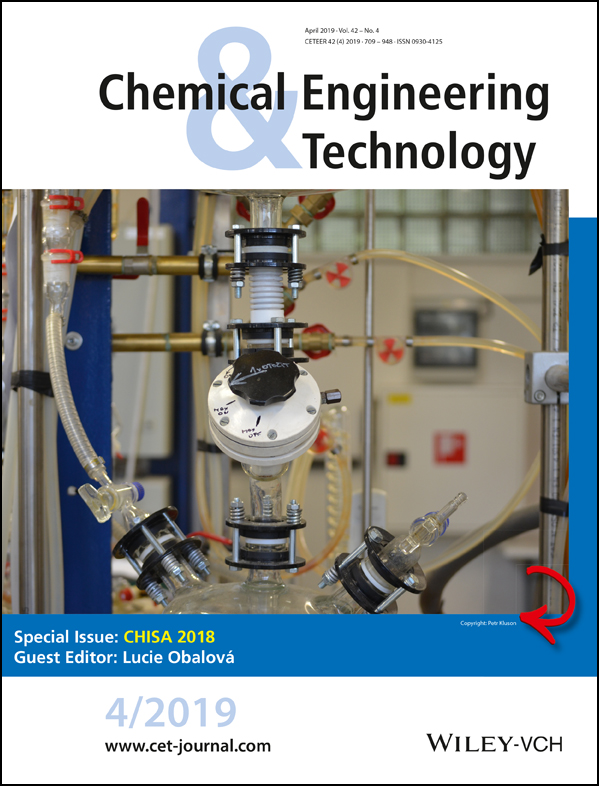Numerical Simulation of Sterilization Processes for Shear-Thinning Food in Taylor-Couette Flow Systems
Corresponding Author
Hayato Masuda
University of Shizuoka, School of Food and Nutritional Science, 1 52-1 Yada, Suruga-ku, 422-8526 Shizuoka, Japan
Kobe University, Complex Fluid and Thermal Engineering Research Center (COFTEC), 2 1-1 Rokkodai, Nada-ku, 657-8501 Kobe, Hyogo, Japan
Correspondence: Hayato Masuda ([email protected]), University of Shizuoka, School of Food and Nutritional Science, 1 52-1 Yada, Suruga-ku, 422-8526 Shizuoka, Japan.Search for more papers by this authorRobert Hubacz
Warsaw University of Technology, Faculty of Chemical and Process Engineering, 3 ul. Waryńskiego 1, 00-645 Warszawa, Poland
Search for more papers by this authorMakoto Shimoyamada
University of Shizuoka, School of Food and Nutritional Science, 1 52-1 Yada, Suruga-ku, 422-8526 Shizuoka, Japan
Search for more papers by this authorNaoto Ohmura
Kobe University, Complex Fluid and Thermal Engineering Research Center (COFTEC), 2 1-1 Rokkodai, Nada-ku, 657-8501 Kobe, Hyogo, Japan
Kobe University, Department of Chemical Science and Engineering, 1-1 Rokkodai, Nada-ku, 657-8501 Kobe, Hyogo, Japan
Search for more papers by this authorCorresponding Author
Hayato Masuda
University of Shizuoka, School of Food and Nutritional Science, 1 52-1 Yada, Suruga-ku, 422-8526 Shizuoka, Japan
Kobe University, Complex Fluid and Thermal Engineering Research Center (COFTEC), 2 1-1 Rokkodai, Nada-ku, 657-8501 Kobe, Hyogo, Japan
Correspondence: Hayato Masuda ([email protected]), University of Shizuoka, School of Food and Nutritional Science, 1 52-1 Yada, Suruga-ku, 422-8526 Shizuoka, Japan.Search for more papers by this authorRobert Hubacz
Warsaw University of Technology, Faculty of Chemical and Process Engineering, 3 ul. Waryńskiego 1, 00-645 Warszawa, Poland
Search for more papers by this authorMakoto Shimoyamada
University of Shizuoka, School of Food and Nutritional Science, 1 52-1 Yada, Suruga-ku, 422-8526 Shizuoka, Japan
Search for more papers by this authorNaoto Ohmura
Kobe University, Complex Fluid and Thermal Engineering Research Center (COFTEC), 2 1-1 Rokkodai, Nada-ku, 657-8501 Kobe, Hyogo, Japan
Kobe University, Department of Chemical Science and Engineering, 1-1 Rokkodai, Nada-ku, 657-8501 Kobe, Hyogo, Japan
Search for more papers by this authorAbstract
The performance of the Taylor-Couette flow apparatus as a heat sterilizer is numerically investigated. The destruction of Clostridium botulinum and thiamine (vitamin B1) was selected as model reaction. When Taylor vortices were formed in the annular space, the heat transfer significantly enhanced as compared to the case without vortex flow. As a result, the equivalent lethality calculated from the temperature field increased, which is regarded as a quantum leap. Conversely, the improvement of heat transfer induced destruction of thiamine. These results suggest that there is a trade-off relationship between the enhancement of heat transfer and the avoidance of thermal destruction of nutritional components. In conclusion, the Taylor-Couette flow sterilizer has the potential for process intensification in heat sterilization processes.
References
- 1 X. Li, M. Farid, J. Food Eng. 2016, 182, 33.
- 2 S. Simpson, M. Williams, J. Food Sci. 1974, 39, 1047.
- 3 J. D. H. Kelder, K. J. Ptasinski, P. J. A. M. Kerkhof, Chem. Eng. Sci. 2002, 57, 4605.
- 4 G. I. Taylor, Philos. Trans. R. Soc. A 1923, 223, 289.
- 5
K. Kataoka, H. Doi, T. Komai, J. Chem. Eng. Jpn.
1975, 8, 472.
10.1252/jcej.8.472 Google Scholar
- 6 K. Kataoka, N. Ohmura, M. Kouzu, Y. Simamura, M. Okubo, Chem. Eng. Sci. 1995, 50, 1409.
- 7 N. Ohmura, T. Suemasu, Y. Asamura, J. Phys. Conf. Ser. 2005, 14, 64.
- 8 R. L. C. Giordano, R. C. Giordano, C. L. Cooney, Process Biochem. 2000, 35, 1093.
- 9 R. Hubacz, N. Ohmura, E. Dluska, J. Food Process Eng. 2013, 36, 774.
- 10 H. Masuda, T. Horie, R. Hubacz, N. Ohmura, Chem. Eng. Res. Des. 2013, 91, 2259.
- 11 H. Masuda, T. Horie, R. Hubacz, N. Ohmura, M. Shimoyamada, Biosci. Biotechnol. Biochem. 2017, 81, 755.
- 12 M. Orlowska, T. Koutchma, M. Kostrzynska, J. Tang, C. Defelice, J. Food. Eng. 2014, 120, 100.
- 13 H. Masuda, T. Horie, N. Ohmura, M. Shimoyamada, Chem. Eng. Trans. 2017, 57, 1753.
- 14 H. Masuda, M. Shimoyamada, N. Ohmura, Int. J. Heat Mass Transfer 2019, 130, 274.
- 15 M. Kaminoyama, K. Nishi, R. Misumi, F. Otani, J. Chem. Eng. Jpn. 2011, 44, 868.
- 16 P. J. Carreau, Trans. Soc. Rheol. 1972, 16, 99.
- 17 M. Ohta, M. Ohta, M. Akiyoshi, E. Obata, Numer. Heat Transfer 2002, 41, 357.
- 18 M. Kaminoyama, M. Watanabe, K. Nishi, M. Kamiwano, J. Chem. Eng. Jpn. 1999, 32, 23.
- 19 Z.-M. Zhao, L. Wang, H.-Z. Chen, Bioresour. Technol. 2015, 192, 547.
- 20 R. Srinivasan, S. Jayanti, A. Kannan, AIChE J. 2005, 51, 2885.
- 21
K. Kataoka, J. Chem. Eng. Jpn.
1975, 8, 271.
10.1252/jcej.8.271 Google Scholar
- 22 C. Y. Ho, J. L. Nardacci, A. H. Nissan, AIChE J. 1964, 10, 194.
- 23 J. E. Burkhalter, E. L. Koschmieder, Phys. Fluids 1974, 17, 1929.
- 24 H. Masuda, T. Horie, R. Hubacz, M. Ohta, N. Ohmura, Rheol. Acta 2017, 56, 73.
- 25 F. Horak, H. Kessler, Z. Lebensm. Unters. Forsch. 1981, 173, 1.
- 26 B. B. Boyaci, J.-Y. Han, M. T. Masatcioglu, E. Yalcin, S. Celik, G.-H. Ryu, H. Koksel, Food Chem. 2012, 132, 2165.
- 27 K. Tyszczuk-Rotko, Food Chem. 2012, 134, 1239.
- 28 M. Ohta, E. Iwasaki, E. Obata, Y. Yoshida, J. Non-Newtonian Fluid Mech. 2003, 116, 95.
- 29 H. Masuda, S. Yoshida, T. Horie, N. Ohmura, M. Shimoyamada, AIChE J. 2018, 64, 1075.
- 30 R. M. Lueptow, A. Docter, K. Min, Phys. Fluids A 1992, 4, 2446.
- 31 J.-Y. Hwang, K.-S. Yang, Comput. Fluids 2004, 33, 97.
- 32 T. V. Gerven, A. Stankiewicz, Ind. Eng. Chem. Res. 2009, 48, 2465.
- 33 S. Ilo, E. Berghofer, J. Food Sci. 1998, 63, 312.




